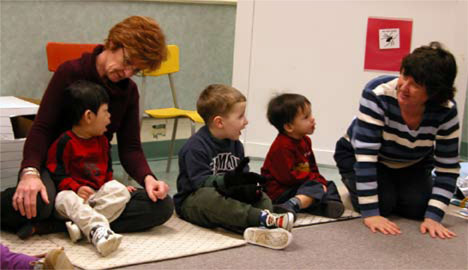
As a parent, teacher or early childhood professional, have you ever had one of these experiences?
- You are having a conversation (with another adult) and your child starts talking to you, interrupting your conversation, or perhaps yells your name from across the room.
- Your child pulls at your clothes or your hand to get you to help her, or to show you something.
Most people can identify with these situations. Many young children do not know how to get someone’s attention in a polite and appropriate manner. Therefore, when they need your attention, they simply call your name or tug at you, regardless of what you may be doing at the time.
Some children also have a hard time getting another child’s attention in an appropriate way. They may hit, or yell at the other child. Children need to learn the appropriate way to get someone’s attention. Like other social skills, this skill can be taught.
Helping your Child Learn How to Get Someone’s Attention
Here are some strategies that you might find helpful in supporting your child as she learns to appropriately get someone’s attention:
- Talk about it
Start by talking to your child about the specific skill. Ask her questions like:
“How can you get someone’s attention if they are talking to someone else?”, or “If Daddy is talking to Mommy, how get you get my attention?”
“How can you get someone’s attention if they are far from you?” - Teach
Teach your child a rule that will help her understand how to get someone’s attention in different situations. A Social Script can be helpful at this stage. It is a way of teaching children how to behave in specific social situations. It might include suggestions of specific things your child can say or do in response to the social situation.Note: Depending on your child’s skill level, you can write a Social Script using words only, or you can add pictures or photographs to help describe each step.
Here is an example of a Social Script written to help a child learn how to “get someone’s attention”:
When I want to talk to someone, I:
- Stand close to them and tap them gently on the shoulder
- Say their name
- Wait for them to look at me
- Talk to them
- Role-Playing
Give your child an opportunity to practise the skill by doing a role play or puppet show. In the beginning, you should play all the ‘parts’ to show your child what she can do or say in certain situations. You can keep her interested by using characters from her favourite television shows. Be sure to speak in an animated voice and use words that your child can understand.Try to act out situations with both positive and negative responses, as this will help your child understand what could happen in different situations.Here are some examples:
Scenario 1
Maisy is reading a book.
Charley walks towards her and says, “Maisy.”. (He waits for her to respond)
Maisy says, “Yes, Charley”.
Charley says, “Maisy, look at my picture. Do you like it?”
Scenario 2
Maisy is reading a book.
Charley is across the room and yells, “Maisy, Maisy! (He does not wait for her to respond)
Charley comes running towards Maisy and says, “Maisy, look at my picture. Do you like it?”
Maisy is angry because she was interrupted.
- Reinforce
Tell your child that you will be watching for this skill for a week. Reinforce your child when you see her following the steps to getting someone’s attention and remember to label the behaviour that you want to see.“Wow! I just saw you get close to Gina, say her name, and wait. You got Gina’s attention without interrupting.” - Review
Talk about the skill for a few minutes each day so that it is fresh in your child’s mind. This also helps her understand the importance of this social skill.
Teaching your child ways to appropriately get someone’s attention can be challenging and takes time. You will be most successful when you are:
PATIENT – Some children might need more reminders, more support, and more time to learn and use the skill.
CONSISTENT – Make sure that you and any other adults in your child’s life have the same expectations of the child.
POSITIVE – Remember to look for your child using the skill and reinforce her as much as possible.
